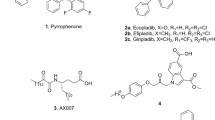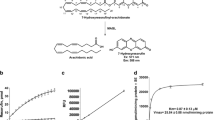Abstract
Phospholipase A2 (PLA2) catalyzes the hydrolysis of phospholipids into arachidonic acid and lysophospholipids. Arachidonic acid is modified by cyclooxygenases into active compounds called eicosanoids that act as signaling molecules in a number of physiological processes. Excessive production of eicosanoids leads to several pathological conditions such as inflammation. In order to block the inflammatory effect of these compounds, upstream enzymes such as PLA2 are valid targets. In the present contribution, molecular dynamic analysis was performed to evaluate the binding of diclofenac, 9-hydroxy aristolochic acid (9-HAA) and indomethacin to PLA2. Obtained results revealed that 9-HAA could form a more stable complex with PLA2 when compared to diclofenac and indomethacin. Furthermore, analysis of intermolecular binding energy components indicated that hydrophobic interactions were dominant in binding process. On the basis of obtained data, inhibitors bearing fused rings with hydrogen acceptor/donor substituent(s) interacted with His48 and Asp49 residues of the active site. More affinity toward PLA2 might be envisaged through negatively charged moieties via interaction with Trp31, Lys34 and Lys69.










Similar content being viewed by others
References
Dennis EA (1994) Diversity of group types, regulation, and function of phospholipase A2. J Biol Chem 269:13057
Smith WL, DeWitt DL, Garavito RM (2000) Cyclooxygenases: structural, cellular, and molecular biology. Annu Rev Biochem 69(1):145–182
Davidson J, Rotondo D, Rizzo M, Leaver H (2012) Therapeutic implications of disorders of cell death signalling: membranes, micro-environment, and eicosanoid and docosanoid metabolism. Br J Pharmacol 166(4):1193–1210
Murakami M, Kambe T, Shimbara S, Kudo I (1999) Functional coupling between various phospholipase A2s and cyclooxygenases in immediate and delayed prostanoid biosynthetic pathways. J Biol Chem 274(5):3103–3115
Smith WL, Marnett LJ, DeWitt DL (1991) Prostaglandin and thromboxane biosynthesis. Pharmacol Ther 49(3):153–179
Smith WL (1992) Prostanoid biosynthesis and mechanisms of action. Am J Physiol-Renal 263(2):F181–F191
Bonventre JV, Huang Z, Taheri MR, O’Leary E, Li E, Moskowitz MA et al (1997) Reduced fertility and postischaemic brain injury in mice deficient in cytosolic phospholipase A2. Nature 390(6660):622–625
Tanioka T, Nakatani Y, Semmyo N, Murakami M, Kudo I (2000) Molecular identification of cytosolic prostaglandin E2 synthase that is functionally coupled with cyclooxygenase-1 in immediate prostaglandin E2biosynthesis. J Biol Chem 275(42):32775–32782
Ma W, Eisenach J (2003) Cyclooxygenase 2 in infiltrating inflammatory cells in injured nerve is universally up-regulated following various types of peripheral nerve injury. Neuroscience 121(3):691–704
Ivanov I, Heydeck D, Hofheinz K, Roffeis J, O’Donnell VB, Kuhn H et al (2010) Molecular enzymology of lipoxygenases. Arch Biochem Biophys 503(2):161–174
Yang K, Bai H, Ouyang Q, Lai L, Tang C (2008) Finding multiple target optimal intervention in disease-related molecular network. Mol Syst Biol 4(1):228–241
Magrioti V, Kokotos G (2010) Phospholipase A2 inhibitors as potential therapeutic agents for the treatment of inflammatory diseases. Expert Opin Ther Pat 20(1):1–18
Webb NR (2005) Secretory phospholipase A2 enzymes in atherogenesis. Curr Opin Lipidol 16(3):341–344
Quach ND, Arnold RD, Cummings BS (2014) Secretory phospholipase A2 enzymes as pharmacological targets for treatment of disease. Biochem Pharmaco 90(4):338–348
Funk CD (2001) Prostaglandins and leukotrienes: advances in eicosanoid biology. Science 294(5548):1871–1875
Arni R, Ward R (1996) Phospholipase A 2—a structural review. Toxicon 34(8):827–841
Valentin E, Lambeau G (2000) What can venom phospholipases A 2 tell us about the functional diversity of mammalian secreted phospholipases A 2? Biochimie 82(9):815–831
Carvalho B, Santos J, Xavier B, Almeida J, Resende L, Martins W et al (2013) Snake venom PLA 2s inhibitors isolated from Brazilian plants: synthetic and natural molecules. Biomed Res Int. doi:10.1155/2013/153045
Damico DC, Vassequi-Silva T, Torres-Huaco F, Nery-Diez A, de Souza R, Da Silva S et al (2012) LmrTX, a basic PLA 2 (D49) purified from Lachesis muta rhombeata snake venom with enzymatic-related antithrombotic and anticoagulant activity. Toxicon 60(5):773–781
Damico DC, da Cruz Höfling MA, Cintra M, Leonardo MB, Calgarotto AK, da Silva SL et al (2008) Pharmacological study of edema and myonecrosis in mice induced by venom of the bushmaster snake (Lachesis muta muta) and its basic Asp49 phospholipase A2 (LmTX-I). Protein J 27(6):384–391
Vasilakaki S, Barbayianni E, Leonis G, Papadopoulos MG, Mavromoustakos T, Gelb MH et al (2016) Development of a potent 2-oxoamide inhibitor of secreted phospholipase A 2 guided by molecular docking calculations and molecular dynamics simulations. Bioorg Med Chem 24(8):1683–1695
Singh N, Jabeen T, Sharma S, Somvanshi R, Dey S, Srinivasan A et al (2006) Specific binding of non-steroidal anti-inflammatory drugs (NSAIDs) to phospholipase A2: structure of the complex formed between phospholipase A2 and diclofenac at 2.7 Å resolution. Acta Crystallogr D 62(4):410–416
Singh N, Kumar RP, Kumar S, Sharma S, Mir R, Kaur P et al (2009) Simultaneous inhibition of anti-coagulation and inflammation: crystal structure of phospholipase A2 complexed with indomethacin at 1.4 Å resolution reveals the presence of the new common ligand-binding site. J Mol Recognit 22(6):437–445
Katzung BG, Masters SB, Trevor AJ (2004) Basic & clinical pharmacology. Lange Medical Books/McGraw-Hill, New York
Morphy R, Kay C, Rankovic Z (2004) From magic bullets to designed multiple ligands. Drug Discov Today 9(15):641–651
Millan MJ (2006) Multi-target strategies for the improved treatment of depressive states: conceptual foundations and neuronal substrates, drug discovery and therapeutic application. Pharmacol Ther 110(2):135–370
Keith CT, Borisy AA, Stockwell BR (2005) Multicomponent therapeutics for networked systems. Nat Rev Drug Discov 4(1):71–78
Chandra V, Jasti J, Kaur P, Srinivasan A, Betzel C, Singh T (2002) Structural basis of phospholipase A2 inhibition for the synthesis of prostaglandins by the plant alkaloid aristolochic acid from a 1.7 Å crystal structure. Biochemistry 41(36):10914–10919
Kini RM (1997) Venom phospholipase a2 enzymes. Sect. chap 1. Wiley
Yu B-Z, Rogers J, Nicol GR, Theopold KH, Seshadri K, Vishweshwara S et al (1998) Catalytic significance of the specificity of divalent cations as KS* and k cat* cofactors for secreted phospholipase A2. Biochemistry 37(36):12576–12587
de Oliveira TC, de Amorim HLN, Guimarães JA (2007) Interfacial activation of snake venom phospholipases A 2 (svPLA 2) probed by molecular dynamics simulations. J Mol Struct-Theochem 818(1):31–41
Heinrich M, Chan J, Wanke S, Neinhuis C, Simmonds MS (2009) Local uses of Aristolochia species and content of nephrotoxic aristolochic acid 1 and 2—a global assessment based on bibliographic sources. J Ethnopharmacol 125(1):108–144
MacKerell AD, Bashford D, Bellott M, Dunbrack R, Evanseck JD, Field MJ et al (1998) All-atom empirical potential for molecular modeling and dynamics studies of proteins. J Phys Chem B 102(18):3586–3616
MacKerell AD, Feig M, Brooks CL (2004) Extending the treatment of backbone energetics in protein force fields: limitations of gas-phase quantum mechanics in reproducing protein conformational distributions in molecular dynamics simulations. J Comput Chem 25(11):1400–1415
Zoete V, Cuendet MA, Grosdidier A, Michielin O (2011) SwissParam: a fast force field generation tool for small organic molecules. J Comput Chem 32(11):2359–2368
Vanommeslaeghe K, Hatcher E, Acharya C, Kundu S, Zhong S, Shim J et al (2010) CHARMM general force field: a force field for drug-like molecules compatible with the CHARMM all-atom additive biological force fields. J Comput Chem 31(4):671–690
Neese F (2011) ORCA 2.8. 0-An ab initio, DFT and semiempirical SCF-MO package. Bonn, Germany
Jorgensen WL, Chandrasekhar J, Madura JD, Impey RW, Klein ML (1983) Comparison of simple potential functions for simulating liquid water. J Chem Phys 79(2):926–935
Allen MP, Tildesley DJ (1987) Computer simulation of liquids. Oxford university press
Hess B (2008) P-LINCS: a parallel linear constraint solver for molecular simulation. J Chem Theory Comput 4(1):116–122
Bussi G, Donadio D, Parrinello M (2007) Canonical sampling through velocity rescaling. J Chem Phys 126(1):014101
Parrinello M, Rahman A (1981) Polymorphic transitions in single crystals: a new molecular dynamics method. J Appl Phys 52(12):7182–7190
Darden T, York D, Pedersen L (1993) Particle mesh Ewald: an N· log (N) method for Ewald sums in large systems. J Chem Phys 98(12):10089–10092
Wlodek ST, Clark TW, Scott LR, McCammon JA (1997) Molecular dynamics of acetylcholinesterase dimer complexed with tacrine. J Am Chem Soc 119(40):9513–9522
Hornak V, Abel R, Okur A, Strockbine B, Roitberg A, Simmerling C (2006) Comparison of multiple Amber force fields and development of improved protein backbone parameters. Proteins 65(3):712–725
Oostenbrink C, Villa A, Mark AE, Van Gunsteren WF (2004) A biomolecular force field based on the free enthalpy of hydration and solvation: the GROMOS force-field parameter sets 53A5 and 53A6. J Comput Chem 25(13):1656–1676
Lindahl M, Tagesson C (1993) Selective inhibition of group II phospholipase A2 by quercetin. Inflammation 17(5):573–582
Acknowledgments
Financial supports of this project by Hamadan University of Medical Sciences are acknowledged. We are also grateful for the support of the Ardabil University of Medical Sciences.
Author information
Authors and Affiliations
Corresponding authors
Rights and permissions
About this article
Cite this article
Ebrahimi, M., Firuzi, O., Miri, R. et al. Structural Insight into Binding Mode of 9-Hydroxy Aristolochic Acid, Diclofenac and Indomethacin to PLA2 . Interdiscip Sci Comput Life Sci 10, 400–410 (2018). https://doi.org/10.1007/s12539-016-0197-0
Received:
Revised:
Accepted:
Published:
Issue Date:
DOI: https://doi.org/10.1007/s12539-016-0197-0




